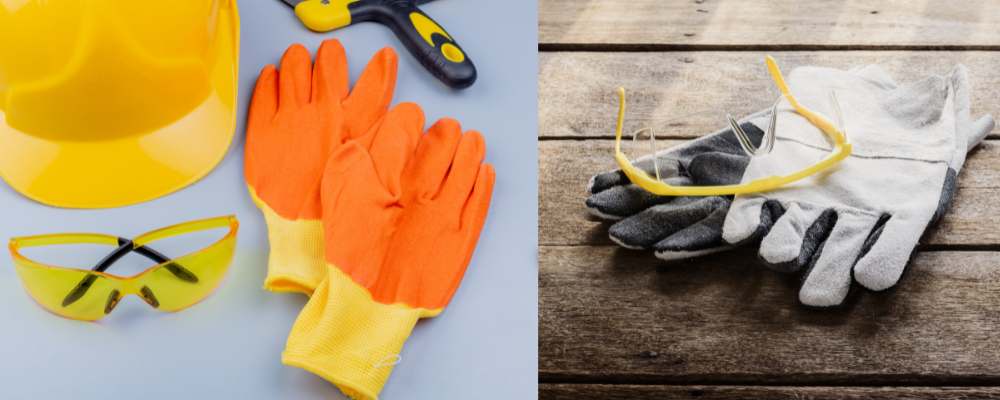
Introduction
The construction industry is where every task, from laying foundations to erecting structures, demands robust physical effort. Amidst the hustle and bustle of this dynamic sector, the significance of hand protection often stands as an understated necessity.
Hand protection in construction isn’t merely a precaution but a fundamental requirement. The hands, the primary tools in most construction tasks, face many hazards daily. From the handling of heavy machinery to exposure to sharp objects and acidic materials, construction workers encounter an array of risks that can lead to debilitating hand injuries.
Statistics and Risks:
Consider this: according to the Bureau of Labor Statistics, hand injuries account for a substantial percentage of total injuries reported annually within the construction industry. Shockingly, a significant portion of these injuries result from insufficient hand protection or the lack thereof.
Insufficient hand protection exposes workers to lacerations, punctures, abrasions, and chemical burns. These injuries not only inflict physical pain but also lead to economic repercussions for both the affected workers and their employers. Lost workdays, medical expenses, and reduced productivity are stark consequences of hand injuries, impacting the overall efficiency of construction projects.
Moreover, studies reveal that using appropriate hand protection gear could have prevented a substantial percentage of hand injuries sustained by construction workers. The gravity of these statistics underscores the pivotal role of quality hand protection in ensuring the safety and well-being of those toiling in the construction sector.
In the subsequent sections, we delve deeper into the various hazards construction workers face and explore the crucial role of proper hand protection in mitigating these risks, ensuring both safety and efficiency on construction sites.
Understanding Hand Hazards in Construction
Common Hand Hazards
Construction sites are rife with various hazards that pose significant risks to the hands of workers. Understanding these hazards is crucial to mitigating potential injuries. Here’s an in-depth look at some prevalent threats:
-
Sharp Objects:
Construction workers often handle sharp tools and materials like nails, glass, metal, and machinery. Accidental contact with these objects can lead to cuts, punctures, and lacerations, exposing workers to infections and severe injuries.
-
Abrasions:
Friction from rough surfaces, machinery, or handling abrasive materials can cause hand abrasions. Though seemingly minor, superficial injuries can become breeding grounds for infections if left untreated.
-
Chemical Exposure:
Handling chemicals, solvents, and various construction materials exposes workers to potential skin irritation, burns, or even systemic health issues through skin absorption.
-
Machinery and Equipment:
Operating heavy machinery or working with equipment such as power tools poses a significant risk of crush injuries, amputations, and severe trauma to the hands if not managed correctly or without proper protective gear.
-
Repetitive Motion:
Repetitive tasks, like using vibrating tools or performing the same movements continuously, can lead to conditions like carpal tunnel syndrome, causing discomfort, pain, and reduced hand function over time.
-
Prevalent Scenarios:
Hand injuries are common during activities such as handling and transporting materials, cutting or shaping materials, operating machinery, and performing demolition work. Accidents often occur due to a lack of proper personal protective equipment or inadequate training.
Impact of Hand Injuries
The repercussions of hand injuries in the construction industry extend far beyond physical pain. The personal and professional impact is substantial:
Personal Impact:
- Pain and Suffering: Hand injuries cause immense physical pain, affecting the worker’s quality of life.
- Reduced Dexterity: Severe hand injuries can lead to permanent impairment or loss of function, impacting daily activities.
- Psychological Effects: Emotional distress and mental health issues might arise due to the trauma of sustaining a significant hand injury.
Professional Impact:
- Economic Consequences: Hand injuries result in medical expenses, rehabilitation costs, and potential loss of income during recovery.
- Loss of Workdays: Time away from work for treatment and recovery reduces productivity, affecting project timelines and deadlines.
- Reduced Productivity: Even after returning to work, limitations in hand function may hinder productivity and efficiency on the job.
Overall Impact:
- Hand injuries affect the injured worker and the entire construction team, causing delays, additional expenses, and potential strain on project completion.
- Understanding the gravity of these hazards and the subsequent impact of hand injuries is fundamental to emphasizing the necessity of adequate hand protection measures on construction sites.
Importance of Proper Hand Protection
Types of Hand Protection Products
4202 Welding Gloves
- Features: Made from heat-resistant materials, suitable for welding tasks.
- Benefits: Protects against burns, sparks, and heat exposure during welding operations—reinforced stitching for durability.
DermiFlex Safety Gloves Black
- Features: Lightweight, breathable, and flexible design for enhanced agility.
- Benefits: Ideal for tasks requiring precision and tactile sensitivity. Offers protection against abrasions and punctures.
MCR Safety® Pigskin Leather Drivers
- Features: Constructed from durable pigskin leather with a comfortable fit.
- Benefits: Provides excellent grip and abrasion resistance. Suitable for driving heavy equipment or tasks requiring a firm grip.
Flexo Grip Nitrile Safety Glove Grey
- Features: Nitrile-coated for oil and chemical resistance.
- Benefits: Offers superior grip in oily conditions, protects against chemical exposure, and ensures hand flexibility.
Radians® AXIS™ Cut Protection Level A2 Foam Nitrile Coated Gloves
- Features: Engineered with cut-resistant materials and foam nitrile coating.
- Benefits: Provides high-level cut protection (A2), ideal for tasks involving sharp tools or materials. Foam nitrile coating enhances grip.
Choosing the Right Hand Protection
Factors to Consider:
- Fit: Ensure gloves fit comfortably without compromising dexterity. Tight gloves can restrict movement, while loose ones might lead to accidents.
- Material: Choose materials based on the hazards present in the task—leather for abrasion resistance, nitrile for chemical protection, etc.
- Durability: Consider the durability of the gloves concerning the tasks’ demands and longevity required.
Guidance on Matching Gloves to Tasks:
- Welding Tasks: Opt for 4202 gloves to protect against heat and sparks.
- Precision Work: Select DermiFlex Safety Gloves Black for tasks requiring dexterity and tactile sensitivity.
- Heavy Equipment Handling: MCR Safety® Pigskin Leather Drivers offer grip and durability for operating heavy machinery.
- Chemical Handling: Flexo Grip Nitrile Safety Glove Grey for protection against chemical exposure.
- Cut-Prone Tasks: Radians® AXIS™ Cut Protection Level A2 Foam Nitrile Coated Gloves for tasks involving sharp tools or materials.
By considering factors like fit, material, and durability, workers can select the appropriate hand protection to ensure safety while performing specific construction tasks effectively.

Best Practices for Hand Safety
Maintaining gloves in optimal condition is crucial for their longevity and effectiveness in protecting hands. Here are essential instructions for caring for and maintaining different types of gloves:
Cleaning:
- Regular Cleaning: Ensure gloves are cleaned regularly, especially after heavy use or exposure to contaminants.
- Proper Technique: Follow manufacturer guidelines for cleaning. Use mild soap or detergent with water for most glove types. For specialty gloves, refer to specific cleaning instructions.
- Avoid Harsh Chemicals: Refrain from using harsh chemicals that might damage the gloves’ material.
Drying:
- Air Dry: After washing, allow gloves to air dry thoroughly before reuse. Avoid exposing them to direct heat sources like sunlight or heaters, as it may cause damage or shrinkage.
Inspection:
- Regular Checkups: Inspect gloves for signs of wear, tear, or damage before and after each use.
- Replace When Necessary: Replace gloves that show signs of significant damage or degradation to ensure continued protection.
Storage:
- Proper Storage: Store gloves in a clean, dry area away from direct sunlight and extreme temperatures.
- Avoid Compression: Avoid folding or compressing gloves excessively to prevent deformation.
Training and Awareness
Importance of Training:
- Comprehensive Training Programs: Implement training sessions focusing on using hand protection in the construction industry.
- Risk Awareness: Educate workers about potential hand hazards they might encounter and the consequences of neglecting hand safety.
Proper Techniques:
- Demonstration: Train workers on the correct gloves-wearing techniques, ensuring proper fit and coverage.
- Task-Specific Training: Guide on selecting appropriate gloves for different tasks.
Encouraging Compliance:
- Regular Reminders: Continuously remind workers to use hand protection through posters, safety meetings, or toolbox talks.
- Lead by Example: Encourage supervisors and experienced workers to wear gloves to set a consistent precedent.
Periodic Reviews and Updates:
- Feedback Loops: Establish a system for workers to provide feedback on glove effectiveness and comfort, allowing for adjustments or updates as necessary.
- Stay Updated: Keep workers informed about any advancements in hand protection technology or new regulations.
Encouragement and Recognition:
- Positive Reinforcement: Recognize and acknowledge workers who consistently adhere to hand protection guidelines, fostering a culture of safety consciousness.
Compliance and Regulations
In the construction industry, ensuring compliance with safety standards and regulations about hand protection is paramount. Several regulatory bodies and standards set guidelines to safeguard workers against hand-related hazards. Both employers and employees must be well-versed in these regulations to mitigate risks effectively.
Overview of Relevant Safety Standards and Regulations
- Occupational Safety and Health Administration (OSHA): OSHA outlines stringent guidelines for hand protection in construction under its Personal Protective Equipment (PPE) standards (29 CFR 1926). It mandates providing, using, and maintaining suitable hand protection where hazards are present.
- American National Standards Institute (ANSI): ANSI provides standards for glove performance and categorizes gloves based on their resistance to cuts, punctures, abrasions, and chemicals. Construction companies often reference ANSI guidelines when selecting appropriate hand protection.
- National Fire Protection Association (NFPA): NFPA standards focus on hand protection concerning fire and electrical hazards in construction. It specifies gloves suitable for these environments to prevent burns and electrocution.
Importance of Compliance with These Standards
Adhering to safety standards is not just a legal requirement but also a crucial aspect of ensuring the well-being of construction workers. Non-compliance can lead to severe consequences, including:
- Worker Safety: Compliance reduces the risk of hand injuries, shielding workers from potential harm and long-term health issues caused by accidents.
- Legal Ramifications: Failure to comply with safety standards can result in fines, legal actions, and damage to a company’s reputation.
- Workplace Efficiency: Following regulations promotes a safer work environment, reducing downtime due to injuries and enhancing overall productivity.
For more information, visit our website and Facebook page.
Here are some products :
MCR Safety® Pigskin Leather Drivers
Flexo Grip Nitrile Safety Glove Grey
Radians® AXIS™ Cut Protection Level A2 Foam Nitrile Coated Gloves
Conclusion
In conclusion, hand protection is a linchpin in construction safety. Considering the risks inherent in construction work, safeguarding one’s hands cannot be overstated. As this blog elucidates, the construction industry demands rigorous compliance with safety standards and hand protection regulations.
To all the dedicated construction workers, your safety matters. Prioritizing hand protection is a fundamental step toward ensuring your well-being on the job. Remember, each task presents potential hazards, making it crucial always to utilize the appropriate hand protection equipment. By embracing these practices and complying with safety standards, you safeguard your health and contribute to a safer and more productive work environment.










